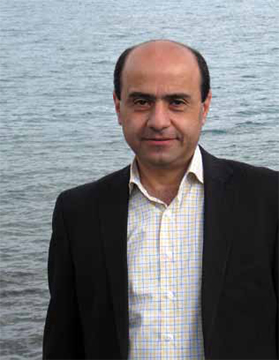
Azat Ordukhanyan
Is Armenia a Geopolitical Football?
by Muriel Mirak-Weissbach
BERLIN, OCTOBER 14, 2021 — As the tensions between Azerbaijan and Armenia escalated in Summer 2020, it became clear to some think tanks and specialists in Germany that this was a kind of proxy conflict. Behind the historical conflict between the two countries, they saw a clash of interests between regional powers. Azerbaijan’s active military engagement role led to a questioning of defined borders and a shift in the balance of power, reigniting a long-term conflict.
On October 4 area specialists convened at the Sozialinstitut Kommende Dortmund, in the Ruhr region, for a seminar on the political situation in Armenia in the wake of the war. The Social Institute is linked to the Archbishopric of Paderborn, also in the Ruhr region, and deals with issues of Christian social ethics. The sponsors of the gathering included the Auslandsgesellschaft, a foreign policy association promoting understanding among peoples in the spirit of peace and humanitarianism, and the Konrad Adenauer Foundation. The latter is a prominent thinktank associated with but independent of the Christian Democratic Party (CDU), founded after World War II to promote European unity, civic education and development cooperation.
The title of the seminar can be roughly translated to “Armenia: Geopolitical Football of the Region’s Powers.” The participants examined the interests pursued by regional powers, their impact of the Armenian people and the implications for the autonomy of the Christian nation. They sought to identify the challenges Armenia faces and the course of its future social development.
Robert Gläsener of the Kommende Dortmund greeted speakers and guests, after which Azat Ordukhanyan delivered the keynote address. Born in Yerevan, Ordukhanyan studied history, pedagogy and theology, and, after moving to Germany in 1993, studied eastern European history at the Ruhr University in Bochum. A journalist, he has been president of the Armenian Academic Society 1860 for two decades and has also served as chairman of the Central Council of Armenians in Germany. He presented an overview of the historical and political development of Armenia, a tour d’horizon covering centuries, or rather millennia. It was a thorough introduction to Armenia, its geography and population, its language and church; from the legendary Hayk, Ordukhanyan took his audience through 5,000 years of history, the dynasties and their cultural achievements, Mesrob and the alphabet. He reviewed the highpoints in Ani, and the arrival of the Seljuks and Mongols; from there to the modern era, the genocide and all-too-brief interlude of the republic, to Soviet Armenia, and to the present. For the past 150 years, he said, Armenia has been “between the Turkish anvil and the Russian hammer,” and concluded that he believed neither was ready to relinquish the position it holds, globally or regionally.
The political challenges facing Armenia were the subject of a talk by Rami-Georg Johann, a political scientist whose doctoral thesis at the Vechta University was on “Theories of Empire-Building in the 21st Century.” Johann began with reference to World War I, citing the Sykes-Picot treaty between Great Britain and France which established the “new world order” that was to reign according to Britain’s divide and rule policy. Henry Kissinger’s definitions laid out the rules and definitions of power that were accepted as “orders,” be it for one area in the world which affects the global balance of power, or a regional order, limited to the specific area. He then reviewed the history of the Caucasus region, from ancient times in the Persian empire to the modern era, before narrowing the focus to the relationship between Azerbaijan and Armenia, once both part of the Russian empire. Karabagh changed hands in 1921 and again in 1988, followed by the outbreak of violence and ultimately war, as the broader picture changed dramatically at the end of the Cold War and the emergence of the USA as presumed world policeman. Moving then to the recent war, Johann examined the role of Russia, as arms supplier to Turkey and Azerbaijan, and ultimately as mediator, facilitated in this by Europe’s lamentable passivity. The diaspora, he said, rallied significant support but did not ultimately impact the policies of Armenia or the outcome of the conflict. As for Turkey, he emphasized the “neo Ottoman war” for raw materials, and Ankara’s political/military interventions throughout the region. His judgment is that “the European Union cannot ignore Erdogan’s imperialism any longer.”
Heide Rieck, author and co-founder with Ordukhanyan of an Armenian cultural project in the region, introduced a literary interlude. Reading from a new anthology she co-edited with Ordukhanyan, she presented the views and experiences of descendants of survivors—a poignant reminder of the long-lasting effects of trauma, whether from the 1915 genocide or the more recent Artsakh conflict.
The role of Christianity in the South Caucasus was the subject of remarks by Ninve Ermagan, a young author who has studied persecution of Christians, protection of minority groups, extremism and the role of women in patriarchal cultural settings. She is a member of a group called Save our Souls 1915, which engages in spreading knowledge and understanding about the genocide against Armenians, Assyrians and Greeks. Following her talk on the role of Christianity as a state religion, the speakers entered a lively exchange with participants on the many questions raised in the course of the day.
Such seminars may not provide the final answers to the crisis, or crises, generated by the recent conflict; but the fact that leading think tanks, like the Konrad Adenauer Foundation, for example, and prominent church affiliated institutions raise the issues in such a forum, itself speaks volumes regarding the perceived need for European actors to awaken from their uneasy slumber and actively take up the challenge posed by the continuing, indeed escalating, aggressivity emanating from Turkey and Azerbaijan. “Erdogan’s imperialism” — a fitting description.